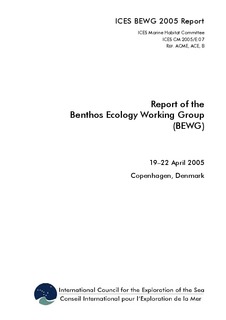| dc.description.abstract | The Benthos Ecology Working Group (BEWG) met from 19–22 April 2005 at the ICES Headquarters in Copenhagen, Denmark. 21 participants from nine countries attended the meet-ing, many of which new and young attendees, re-juvenated the group. Heye Rumohr, Ger-many, acted as Chair, Hans Hillewaert was editing Rapporteur assisted by daily Rapporteurs.
The agenda comprised reports from ICES meetings and other meetings of interest as well as reports of on-going cooperative studies and other studies on benthic ecology questions rele-vant to ICES. This included a first-hand report from M. Tasker, Chair of WGDEC, on the re-cent meeting of this newly established Working Group.
In order to contribute to the REGNS process, available metadata about long-term time-series and long-term comparisons of benthic communities in the North Sea were compiled. Metadata about long-term benthos studies, which were previously compiled within the German project SYCON, were used as a starting point. The metadata set was extended and modified during this workshop. The following benthic categories were considered: soft bottom endobenthos, soft bottom epibenthos, and hard bottom epibenthos. Due to the importance of historical data for long-term comparisons, an additional table concerning the oldest available benthos data-sets in the North Sea was added.
There was not enough experience of the current framework for environmental risk assessment within the BEWG of the long term effects of oil pollution. However, a preliminary list of rec-ommendations for the assessment of the long-term effects of oil pollution was provided.
BEWG recognized the challenge of matching the aspirational need for a small suite of widely applicable benthic biological indicators with the typical local sources of evidence for deter-mining effectiveness. Thus the utility of an individual indicator may vary with locality (espe-cially habitat type) and the activity under investigation so that, in practice, a larger ‘toolkit’ of measures was required to meet different circumstances. No universally applicable measure was yet available. BEWG recognises the need to further develop this work to actually list those indicators available based on the published case studies as a meta-analysis in a future meeting. Our aim is to recommend that both indicators of state and those that identify cause-effect relationships with human activities (performance indicators) can be recommended. We also emphasize the need to test the applicability of different indicators at local, regional and global levels in order to aid the development of appropriate monitoring programmes.
Despite recent efforts to explore the fauna and habitats on the mid-Atlantic Ridge, rather few areas of the mid-Atlantic Ridge have been mapped in detail. The limited areas that have been explored by Remotely Operated Vehicles (ROVs) show a vulnerable habitat and a diverse sessile fauna, not unlike those found in other waters that have similar habitats and which have been explored more fully. However, the level of knowledge of the MAR or other Atlantic seamounts is not sufficient to determine what areas are most vulnerable or have been most damaged by trawling
Investigations by the wind farm developers on ecological effects involve a high sampling ef-fort and are quite expensive. For economic reasons, these investigations will mostly be at a minimum required effort. To ensure a scientifically sound result, a minimum standard should be established by all national regulating bodies. Especially in areas where proposed wind farms touch national borders, an international harmonization is necessary to make comparison of results possible and to assess cumulative effects, which do not stop at national borders. To allow thorough assessment of effects across various regions and habitats, all data produced in environmental studies should be collected centrally and consequently be available for scien-tific purposes. A distinction between natural spatial variation and wind farm effects will require multiple reference areas. This may also be achieved by a combined analysis of data from several pro-jects, combining data from all reference areas to estimate natural variation. This will require a central data collection and a common minimum standard for the data produced to allow com-parisons between studies. To allow a differentiation of fishing effects and direct effects of offshore wind farm installations, at least some reference areas without fishing influence will be needed. The group decided to tackle environmental implications from energy generation from wind, waves and tidal currents under one headline. | en |
